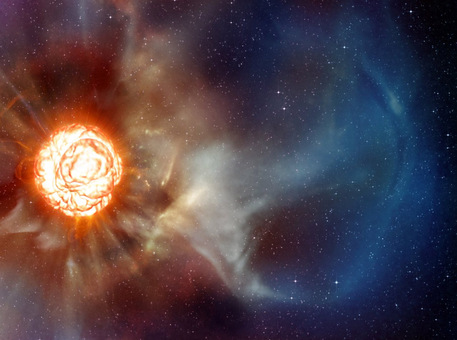Sharp view on Betelgeuse
Betelgeuse's rapid weight loss program
 © ESO/L. Calçada |
This artist’s impression shows the supergiant star Betelgeuse as it was revealed thanks to different state-of-the-art techniques on ESO’s Very Large Telescope, which allowed two independent teams of astronomers to obtain the sharpest ever views of the supergiant star Betelgeuse.
Red supergiants still hold several unsolved mysteries. One of them is just how these behemoths shed such tremendous quantities of material — about the mass of the Sun in only 10 000 years. Two teams of astronomers have used ESO’s Very Large Telescope (VLT) and the most advanced technologies to take a closer look at the gigantic star. Their combined work suggests that an answer to the long-open mass-loss question may well be at hand.
The first team used the adaptive optics instrument, NACO, combined with a so-called “lucky imaging” technique, to obtain the sharpest ever image of Betelgeuse, even with Earth’s turbulent, image-distorting atmosphere in the way. With lucky imaging, only the very sharpest exposures are chosen and then combined to form an image much sharper than a single, longer exposure would be.
The resulting NACO images almost reach the theoretical limit of sharpness attainable for an 8-meter telescope. The resolution is as fine as 37 milliarcseconds, which is roughly the size of a tennis ball on the International Space Station (ISS), as seen from the ground.
“Thanks to these outstanding images, we have detected a large plume of gas extending into space from the surface of Betelgeuse,” says Pierre Kervella from the Paris Observatory, who led the team. The plume extends to at least six times the diameter of the star, corresponding to the distance between the Sun and Neptune.
“This is a clear indication that the whole outer shell of the star is not shedding matter evenly in all directions,” adds Kervella. Two mechanisms could explain this asymmetry. One assumes that the mass loss occurs above the polar caps of the giant star, possibly because of its rotation. The other possibility is that such a plume is generated above large-scale gas motions inside the star, known as convection — similar to the circulation of water heated in a pot.
The observations revealed that the gas in Betelgeuse's atmosphere is moving vigorously up and down, and that these bubbles are as large as the supergiant star itself. Their unrivaled observations have led the astronomers to propose that these large-scale gas motions roiling under Betelgeuse’s red surface are behind the ejection of the massive plume into space.
Sharp view on Betelgeuse
Betelgeuse's rapid weight loss program
 © ESO/L. Calçada |
This artist’s impression shows the supergiant star Betelgeuse as it was revealed thanks to different state-of-the-art techniques on ESO’s Very Large Telescope, which allowed two independent teams of astronomers to obtain the sharpest ever views of the supergiant star Betelgeuse.
Red supergiants still hold several unsolved mysteries. One of them is just how these behemoths shed such tremendous quantities of material — about the mass of the Sun in only 10 000 years. Two teams of astronomers have used ESO’s Very Large Telescope (VLT) and the most advanced technologies to take a closer look at the gigantic star. Their combined work suggests that an answer to the long-open mass-loss question may well be at hand.
The first team used the adaptive optics instrument, NACO, combined with a so-called “lucky imaging” technique, to obtain the sharpest ever image of Betelgeuse, even with Earth’s turbulent, image-distorting atmosphere in the way. With lucky imaging, only the very sharpest exposures are chosen and then combined to form an image much sharper than a single, longer exposure would be.
The resulting NACO images almost reach the theoretical limit of sharpness attainable for an 8-meter telescope. The resolution is as fine as 37 milliarcseconds, which is roughly the size of a tennis ball on the International Space Station (ISS), as seen from the ground.
“Thanks to these outstanding images, we have detected a large plume of gas extending into space from the surface of Betelgeuse,” says Pierre Kervella from the Paris Observatory, who led the team. The plume extends to at least six times the diameter of the star, corresponding to the distance between the Sun and Neptune.
“This is a clear indication that the whole outer shell of the star is not shedding matter evenly in all directions,” adds Kervella. Two mechanisms could explain this asymmetry. One assumes that the mass loss occurs above the polar caps of the giant star, possibly because of its rotation. The other possibility is that such a plume is generated above large-scale gas motions inside the star, known as convection — similar to the circulation of water heated in a pot.
The observations revealed that the gas in Betelgeuse's atmosphere is moving vigorously up and down, and that these bubbles are as large as the supergiant star itself. Their unrivaled observations have led the astronomers to propose that these large-scale gas motions roiling under Betelgeuse’s red surface are behind the ejection of the massive plume into space.





